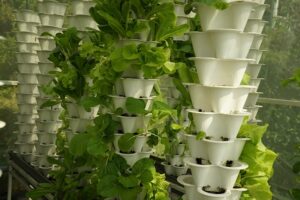Imagine a garden that climbs walls instead of sprawling across your yard. Vertical gardens offer a unique and beautiful way to bring green into urban spaces and compact homes. But like any garden, they require the right care to thrive. This guide dives deep into vertical garden irrigation, an essential component for healthy plants and eco-friendly living.
The Importance of Proper Irrigation in Vertical Gardens
Vertical gardens are on the rise, offering a perfect solution for those with limited outdoor space. However, successful vertical gardening is not just about choosing the right plants; it’s about providing them with adequate water. Proper irrigation ensures that every plant, from top to bottom, receives the moisture it needs to flourish. Unlike traditional gardens, where gravity helps water distribute evenly, vertical gardens require a strategic approach to watering. This section will explore why irrigation is crucial and the common issues that arise when it’s not done correctly.
Why is Irrigation Crucial in Vertical Gardening?
- Promotes even growth and distribution of water to all plants
- Prevents overwatering and root rot
- Maximizes plant health and productivity
Common Issues with Improper Irrigation in Vertical Gardens
- Uneven watering leads to stressed and dying plants
- Overwatering causes soil erosion and leaching of nutrients
- Underwatering results in stunted growth and damaged foliage
Now that we understand why irrigation is critical let’s dive into some techniques for sustainable vertical garden irrigation.
Sustainable Water Conservation Techniques for Vertical Gardens
Water conservation is vital, regardless of the type of garden you have. However, it’s even more critical for vertical gardens as they require more frequent watering due to their unique structure. Here are some sustainable irrigation techniques that can help you conserve water while maintaining a healthy vertical garden:
Drip Irrigation Systems
Drip irrigation systems involve using tubes or hoses with small holes or emitters to deliver water directly to the roots of plants. This method is highly efficient and minimizes water waste by targeting specific areas, making it perfect for vertical gardens.
Rainwater Harvesting
Collecting rainwater is an excellent way to reduce your water usage and save money on utility bills. You can install a rain barrel or cistern to collect water from your roof and use it to irrigate your vertical garden.
Mulching
Mulch helps to retain moisture in the soil, reducing the frequency of watering. It also adds nutrients to the soil and suppresses weeds, making it an essential part of sustainable irrigation in vertical gardens.
Micro-Sprinkler Systems
Micro-sprinklers work similarly to traditional sprinkler systems but are designed for smaller areas such as vertical gardens. They deliver a fine mist of water directly on the plants, minimizing evaporation and waste.
Conclusion
Proper irrigation is crucial for successful vertical gardening, and adopting sustainable techniques can help you maintain a healthy and thriving garden while conserving water. By using methods such as drip irrigation, rainwater harvesting, mulching, and micro-sprinkler systems, you can reduce your water usage and create a more sustainable garden. Remember to regularly monitor the moisture levels in your vertical garden and adjust your irrigation accordingly to ensure optimal plant growth. With these techniques, you can enjoy a beautiful and eco-friendly vertical garden for years to come. So don’t wait any longer – start implementing these sustainable irrigation methods today! Happy gardening! 🌱🌿🌻 Stay green, stay happy! 🌎💚
So don’t wait any longer – start implementing these sustainable irrigation methods today! Happy gardening! 🌱

